The IGP Chronicles Part 3: NVIDIA's GeForce 9300
by Anand Lal Shimpi & Gary Key on October 15, 2008 12:00 AM EST- Posted in
- Motherboards
The importance of GPU performance is increasing; if it weren't, Intel wouldn't be so feverishly working to bring Larrabee to market and Apple wouldn't have announced a switch away from Intel chipsets two years after adopting them. GPU accelerated applications are finally beginning to get some exposure; Adobe's recent Photoshop CS4 introduction is the perfect example. If more big-name developers deliver GPU accelerated applications that matter, having a higher performance integrated graphics solution becomes more interesting.
Things have been amazingly quiet on the Intel chipset front. Once the AMD-ATI acquisition was announced, development on ATI Intel chipsets all but halted as did shipments of ATI's chipsets to motherboard makers - no one was looking to touch that beast with a 10 foot pole. That left Intel and NVIDIA as the only providers for Intel chipsets.
We finally got G45 a couple of months ago, but in many ways it was a mild upgrade to G35 rather than the platform we'd all been waiting for. NVIDIA has had its gloves on and eyes set on causing Intel trouble wherever possible, so it's not a surprise that NVIDIA's G45 killer is set up to look even stronger on paper.
The GeForce 9300 and 9400 are similar in many ways to the GeForce 8200/8300 from the AMD world, but obviously since we're talking about non-Nehalem Intel platforms they do have a few changes like the inclusion of a memory controller. Like their AMD counterparts however, the GeForce 9300/9400 are single-chip solutions and unlike the 8200/8300 they are built on a smaller 65nm manufacturing process.
| AMD 780G | Intel G45 | NVIDIA GeForce 9400 | NVIDIA GeForce 9300 | NVIDIA GeForce 8200 | |
| CPU | AMD Socket-AM2 | Intel LGA-775 | Intel LGA-775 | Intel LGA-775 | AMD Socket-AM2 |
| Manufacturing Process | 55nm | 65nm | 65nm | 65nm | 80nm |
| FSB | N/A | 800 / 1066 / 1333MHz | 800 / 1066 / 1333MHz | 800 / 1066 / 1333MHz | N/A |
| Memory Controller | N/A | 2 x 64-bit DDR2/DDR3 channels | 2 x 64-bit DDR2/DDR3 channels | 2 x 64-bit DDR2/DDR3 channels | N/A |
| Memory Speeds Supported | N/A | DDR2-800/667 DDR3-1066/800 |
DDR2-800 DDR3-1333 |
DDR2-800 DDR3-1333 |
N/A |
| PCI Express | 22 PCIe 2.0 lanes | 16 PCIe 2.0 lanes | 20 PCIe 2.0 lanes | 20 PCIe 2.0 lanes | 19 PCIe 2.0 lanes |
| Graphics | Radeon HD 3200 | GMA X4500 | GeForce 9400 mGPU | GeForce 9300 mGPU | GeForce 8200 mGPU |
| Core Clock | 500MHz | 800MHz | 580MHz Core / 1.4GHz Shader | 450MHz Core / 1.2GHz Shader | 500MHz Core / 1.2GHz Shader |
| Shader Processors | 8 (5-way) | 10 | 16 | 16 | 8 |
| Full H.264/VC-1/MPEG-2 HW Decode | Yes | Yes | Yes | Yes | Yes |
| 8-channel LPCM | No | Yes | Yes | Yes | Yes |
The single-chip design does help enable small form factors as you can get a little more compact with your motherboard layout, but this is mainly an advantage on the mobile side (or with non-standard desktop form factors, e.g. iMac). Built on a 65nm process we should actually see power consumption fairly competitive with Intel's G45, especially given that Intel's ICH10 is built on a 130nm process while the G45 is 65nm.

Feature-wise we do get some upgrades over NVIDIA's previous chipsets, exclusively in the graphics department, which we'll get to shortly. Finally, GeForce 9300 boards should be selling for around $100 on average with availability shortly.










47 Comments
View All Comments
Badkarma - Wednesday, October 15, 2008 - link
Why would it be impossible to stream media? Most media streams are only a fraction of 100Mbit ethernet, even a full Blu-ray disc rarely hits 20+Mbit. The CPU usage charts for network traffic in this review are for full thoroughput tests, the NIC will never come close to pushing that much traffic when streaming media.Zstream - Wednesday, October 15, 2008 - link
I stream 300mbs/sec all the time on my HTPC with my gig Intel nic. I guess you never streamed across multiple devices. It is called VOD, if you do not believe me look at the newest tivo.R3MF - Wednesday, October 15, 2008 - link
Is this the chipset that nvidia is supposed to have worked with Via on to ensure Nano support?A HP mininote v2 using Nano and this mGPU would be an awesome product that would take a dump on every other netbook from a great height!
Hlafordlaes - Wednesday, October 15, 2008 - link
That's my understanding, too. I was wondering what the delay was caused by, now my guess is that Apple wanted the exclusive for launch. Let's hope some new mini-ITX 2.0 Nano boards with this chipset will appear soon.R3MF - Wednesday, October 15, 2008 - link
A lot of netbook newsites are reporting drastic price cuts in the mininote 2133, which is fueling speculation that a v2 may be due out soon.As it happens; there is already a petition requesting HP use the Nano + MCP79 combo in a future v2 mininote:
http://www.petitiononline.com/mininote/petition.ht...">http://www.petitiononline.com/mininote/petition.ht...
R3MF - Wednesday, October 15, 2008 - link
This chipset in ULV form is the one being used in the new MacbookAir, so there is no reason why it couldn't be used in netbooks like the HP Mininote, as adequately demonstrated in the power consumption page of this preview.R3MF - Thursday, October 16, 2008 - link
Do you have any thoughts or speculations you would like to share on whether this is the fabled Via Nano integrated chipset?It would be big news for those of us awaiting a powerful HP mininote v2..........